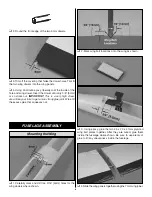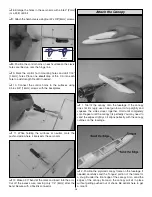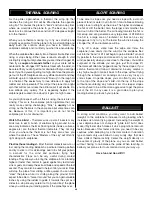
As the glider approaches a thermal, the wing tip that
reaches the rising air first will be lifted before the opposite
wing tip. This causes the plane to “bank” and turn away from
where we would like the plane to go. The best way to get
back in is to continue the bank and turn 270 degrees straight
into the thermal.
When you are thermal soaring, try to fly as smoothly and
straight as possible. Trim the plane to fly in a straight line and
only
touch the controls when you have to. Watch the
sailplane carefully and it will tell you what it is encountering.
When the sailplane flies directly into a thermal it will either start
rising or stop sinking. Either case is reason enough to start
circling. Fly straight until you feel like you are in the strongest lift,
then fly a
couple of seconds farther
so your circle will be
centered in the strongest lift. Thermals travel with the wind, so
be careful that you don’t get too far downwind that you can’t get
back. If you find yourself getting too high, don’t dive the plane to
get out of the lift. Sailplanes are very efficient aircraft and they
will build up a lot of speed and could “blow up” in the rough air
of a thermal. The easiest way to lose altitude is to apply full
rudder and full up elevator. This will put the plane into a tight
spin that will not over stress the airframe but it will enable it to
lose altitude very quickly. This is especially helpful if the
sailplane gets sucked into a cloud or it gets too high to see.
As you might expect, with all this air rising, there is also air
sinking. This air is the sailplane pilot’s nightmare that can
really make soaring challenging. “Sink” is
usually
not as
strong as the thermals in the same area but sometimes can
be. Because of this, it is important you do not let the
sailplane get too far downwind.
Watch the birds! -
Thermals suck up small insects many
birds love to eat. A bunch of swallows flying around in one
area may indicate a thermal. Soaring birds (hawks, vultures,
eagles etc.) are the best thermal indicators. They not only
show you where the thermal is but they also show you
where the center is. These “Masters of the sky” will often fly
right along with sailplanes.
Practice those landings! -
Most thermal contests are won or
lost during the landing. Establish a particular landing pattern
and try to stick to it for all landings. Learn to shift your pattern
to account for the wind and particular flying field
characteristics. Flaps can be very useful during contest
landings. They allow you to bring the sailplane in for a landing
higher or faster than normal to guard against any last minute
sink or gusts and dump the extra altitude and speed at the last
second. They can also be used to help control your skid. Flaps
will stop the plane from sliding a little quicker. You can also
“steer” the plane while it is sliding along the ground. Don’t
expect to be able to “horse it around” but you can gain valuable
inches by using the rudder to guide it towards the spot as it
slides to a stop. Be very careful not to “ground loop” the plane
since you will lose your landing points if the plane flips over.
To be able to slope soar, you need a slope with a smooth
piece of land (or water) out in front of it and a breeze blowing
pretty close to straight up the slope. The higher and steeper
the hill or cliff the better. Also the larger and smoother the
land out in front the better. The air flowing towards the hill, is
forced up and can generate a very large area of lift. Behind
the hill is a large area of turbulent air that can be very
dangerous to try to fly in. The faster the wind is blowing the
stronger the lift and turbulence will be.
To fly off a slope, stand near the edge and throw the
sailplane (nose down) into the wind. As the sailplane flies
out into the “band” of lift it will begin to gain altitude. Turn and
fly parallel to the slope and make all of your turns into the
wind (especially when you are close to the slope).You will be
surprised at the altitude you can gain just from slope lift.
Thermals will often be “popped loose” by these slopes. If you
catch a thermal and follow it downwind, be very careful to
stay high enough to make it back to the slope without flying
through the turbulent air. Landings can be very tricky on
some slopes. On gentle slopes you can often fly very close
to the top of the slope and “slide” into the top of the slope
without encountering any turbulent air. On steeper slopes
you may have to be a little more aggressive to get the plane
out of the lift. In any case it is a good idea to plan your
landing before you launch your plane.
In strong wind conditions, you may want to add ballast
(weight) to the sailplane to increase its wing loading which
increases its normal flying speed. Increasing the weight of
your sailplane does not change its “glide ratio” but it does
make it
fly
faster which makes it sink a proportional amount
faster. Because of this faster sink rate, you need to be very
cautious when ballasting for a thermal contest. In duration
type contests only use ballast on very windy days that also
have a
lot
of thermal activity. Center the weight directly on
the center of gravity of the plane so you can add ballast
without having to re-balance the plane. When learning to
ballast your plane, start out small and work your way up.
Have fun and Good lift!!
BALLAST
SLOPE SOARING
THERMAL SOARING
22



































